Audi invited us to take a look at one of their latest creations carrying the RS badge; the Audi RS7 Sportback! First introduced at the Detroit Motor Show in January, the RS7 promises a package where beauty meets beast. We went to the Audi factory in Neckarsulm to find out!
The RS7 is the last model in the Audi A7 line that celebrated its initial debut at the 2010 Paris Motor Show. The Sportback model is based on the platform of the A6 and Audi’s first step in the four-door luxury coupe market. Last year the sportier S7 joined the lineup, paving the way for the introduction of the ultra-RS7.
The Engine
At the heart of the RS7 is a new uprated twin-turbo version of the 4.0 V8 TFSI engine also found in the S7. The engineers at Quattro GmbH, the company responsible for the RS models, managed to squeeze out another 140hp, lifting its output to a more than impressive total of 560hp.
Audi has made downsizing one of the cornerstones of its strategy and with success. The 560hp is available between 5,700 and 6,700 rpm. A constant 700 Nm of torque are available between 1,750 and 5,500 rpm. Because the high-revving four-liter engine has been rigorously designed for low load-change and flow losses, it develops this power quickly and spontaneously.
The most innovative efficiency technology in the new Audi RS 7 Sportback is the cylinder on demand (COD) system. At low to medium loads and engine speeds, it deactivates cylinders 2, 3, 5 and 8 by closing their valves via electromechanical actuators. The 4.0 TFSI then runs as a four-cylinder engine until the driver accelerates more strongly again. The operating points in the active cylinders are displaced toward higher loads, increasing efficiency.
Gearbox & Drivetrain
The standard ZF eight-speed tiptronic is specially tuned to the sporty character of the Audi RS 7 Sportback. The lower gears of the tiptronic are closely spaced for sporty response, the eighth gear is tall like an overdrive to reduce fuel consumption. The 8-speed tiptronic moves well in auto mode but take over yourself with the flappy pedals and it shows some flaws. Upshifts and downshifts take longer than the 7-speed dual clutch in the S7 and sometimes when you shift close to the red line you might end up shifting a gear further immediately.
The Audi RS 7 Sportback comes standard with quattro permanent all-wheel drive with a central differential with a high locking rate. It distributes the power as needed within a wide range between the front and rear axles. In the standard configuration, 60 percent flows to the rear and 40 percent to the front.
Performance
Besides downsizing, Audi applied another cornerstone of its strategy to the RS7: Lightweight. Using a mix of high strength steel and aluminium in combination with a lighter V8 engine the weight is kept under 2 tonnes, 1,995 kg to be exact.
This allows for some incredible figures: The RS7 Sportback sprints from 0 to 100 km/h in under 3.9 seconds. We did a test run that showed the RS7 passed the 100 km/h mark from standstill in an incredible and supercar worthy 3,6 seconds.
Without ticking any of the optional extras Audi limits the top speed to 250 km/h, however with the optional dynamic package this is raised to 280 km/h and even 305 km/h with the dynamic plus package. It reaches this speed near flawless, set the engine and gearbox setting to dynamic and the 8-speed gearbox will only shift up to 7th gear when you pass the 280 km/h mark.
Suspension
The Audi RS7 offers two options; the standard adaptive air suspension or the RS sport suspension with Dynamic Ride Control (DRC). DRC includes a clever hydraulic system that eliminates body roll, comparable a little bit to the system found in a McLaren 12C. Both the adaptive air suspension as the RS sport suspension offer three settings: Comfort, Auto and Dynamic.
We drove two different versions of the RS7 with both the air suspension and the sport suspension with DRC. The dynamic of the car changes fundamentally with the settings you chose. The sporty DRC is so harsh in dynamic that you are bouncing in the car like a 16 year old at a techno party, even on smooth roads or many race tracks it will be too hard and at higher speeds on the autobahn simply unsettling the car over bumps.
Instead set it back to auto and enjoy a balanced smooth ride on the straights and a flat and rather stiff RS7 through the corners. Comfort mode offers a ride that is not as smooth as the air suspension in comfort but certainly enjoyable on long journeys. Overall the air suspension offers far more comfort, especially in combination with the 20” inch wheels compared to the 21” fitted on our DRC test car, but lacks the sporty touch and the cornering abilities of the DRC equipped car.
Interior
The RS7 interior is finished in the highest quality materials similar to the A7 and S7. New on the RS are several RS badges, floormats and RS seats, as well as carbon fibre parts used to spice up the interior.
The seats offer plenty of support and can be equipped with seat cooling and massage function as optional extra. Several entertainment options from bluetooth media player connections to DAB radio are available. Opt for the integrated rear seat entertainment and this could very well be one of the best fast family cars on the market today.
Design
The RS7 Sportback has a sleek four-door coupe design with plenty of room for individualization. As the example below shows playing with the specification of your RS7 can make a huge difference in its overall appearance. Opt for the Suzuka Grey colour, 21” wheels, carbon fibre exterior package and Quattro logo in the grill and it looks like the racer it is underneath.
On the other hand opt for a more traditional color, the standard 20-inch forged wheels, parts in body color and leave away the RS7 badges and you have the perfect wolf in sheep’s clothing.
Driving Experience
What is the RS7 like to drive than? Essentially there are two types of RS7, the laid back RS7 with air suspension and without any of the sporty dynamic packages. And the stiffer, louder RS7 with Dynamic Plus package and the sport suspension. Between the two is a huge difference in both the ride itself as the overall experience.
We opt for the sportier setup first and take it out for a test drive in the German countryside near the factory of Audi in Neckarsulm. The ‘Car’ menu allows you to setup everything from the engine and gearbox responds, the power steering, the suspension, to the volume of the RS sport exhaust and aggressiveness of the adaptive cruise control. Each offers three settings, Comfort, Auto and Dynamic. There are also some general pre-defined settings that set everything to Comfort or Dynamic while Individual allows you to set everything yourself.
We switch everything to Dynamic and drive off. The ride with the DRC suspension on Dynamic is so harsh that it doesn’t take long until we switch it to Auto which improves the ride and the driveability considerably. We drive through the outskirts of Neckarsulm and enter the A6 highway, the first stretch has a speed limit of 130 km/h but after a while it opens to three lanes and no speed limit. We leave the gearbox in S-automatic mode and put our foot down as soon as the left lane opens up.
The RS7 sprints effortlessly from 120 km/h to well over 250 km/h. With the Dynamic Plus package the top speed is increased to 305 km/h but even close to the 300 km/h mark the car is still pulling hard. Traffic in your lane, the ceramic brakes grip with immense force and slow you down for a moment you cruise in tranquility but step back on the throttle and the car propels forward leaving the car that was just in front of you appear in the rear view mirror as if it is standing still.
Approaching a slight bend, an issue that we experienced before with the S7 resurfaces, the steering (regardless of the setting) feels indirect and very artificial. In a way the steering feels over-engineered.
After a few short sprints the unlimited section of the autobahn ends and we take the exit to turn around. With the exhaust and engine warmed up we switch through various modes including those that set the exhaust volume.
The RS7 is very well isolated and even at higher speeds hardly any outside noise penetrates the cabin. Also you can hardly hear any significant engine sound but the exhaust in dynamic mode bangs like an empty milk carton that explodes. A unique and addictive sound that returns nearly every time you shift up or down. So addictive in fact that you are guaranteed to burn more fuel than necessary just to listen to it!
Talking about fuel, Audi claims 9.8 liters of fuel per 100 km is possible and we have no doubt about that. But if you want to have a bit of fun and unleash that screaming potential of the RS7 on a regular basis expect to add a liter or 10.
Leaving the Autobahn behind us, we steer the RS7 over B-roads for over 100 km. The Audi RS7 with just a driver inside weighs in at nearly 2,100 kg. Certainly not a lightweight and nimble car but its pace and grip are outstanding thanks to the four-wheel drive system, PDC and limited slip differential. The RS7’s handling however is quite clinical and lacks a certain emotion that many purist will crave.
Back at the factory we swapped the ‘hardcore’ Dynamic Plus RS7 for a more modestly equipped RS7. Besides the air suspension this RS7 also doesn’t have the ceramic brakes, limited slip differential and the sport exhaust. It still offers three settings for the exhaust sound but it will never get close to the tingling tune and backfire produced by the sport exhaust.
The ride is more comfortable but with the lack of PDC there is also more body roll in the corners. It still goes like hell in a straight line but it doesn’t feel as tight when a corner arrives. With the different wheels the RS7 looks different too and you hardly get any looks from other motorists compared to the Suzuka Grey RS7 on 21” wheels. It feels as if you swap from a Lamborghini to a Golf. Those ‘in the know’ will still recognize it as something special, but put your foot down and you will leave everybody in awe.
What to spec?
We spend a day testing the various options and packages available for the RS7 and here are some optional extras you should definitely consider to add to your RS7 order:
- Dynamic Package: Includes the Sport Differential, RS Sport Suspension (leave it in Auto) and increased top speed of 280 km/h. If you live in Germany or drive extra sporty consider the Dynamic Plus Package which includes a further increase of the limiter to 305 km/h and the Ceramic brakes. It comes at a hefty price though and it is doubtful if the brakes and increased top speed are worth the extra 8,000 euro.
- RS Sport Exhaust: The must-have for the great RS7 tune.
- Seat cooling, our favorite feature to cool us down on hot summer days.
- Assistance & Safety Package, includes Lane Assist and Adaptive Cruise Control with Stop & Go function among other safety systems. The RS6 and RS7 both allow the adaptive cruise control to be set up to speeds of 250km/h, compared to 180-200 km/h for many competing systems. Both systems make long journeys much more comfortable and safer.
How does it compare to the Audi S7?
Despite its character as an excellent and fast grand tourer we missed a great sense of sportiness in the S7. The RS7 definitely adds a great deal of sportiness over the S7 with its powerful engine, tremendous performance, the must-have sport exhaust, increased top speed and optional sport suspension.
A major difference is the gearbox, where the S7 comes with Audi’s own 7-speed double clutch gearbox, the RS7 has a ZF 8-Speed with a single clutch. Audi claims the 8-speed is a better fit for the RS7, but increasing desire to keep fuel economy as low as possible also plays a role. The 8th gear in the RS7 works as an overdrive and reduces average fuel economy to nearly the same level as the 140hp weaker S7.
Some issues of the S7 still exist in the RS7; steering feels quite indirect and artificial, while the handling is not as dynamic as one would like.
How does it compare to the Audi RS6?
The Audi RS6 and RS7 have a lot in common, apart from their designs and a minor weight difference all essential systems and even the key performance statistics are the same. Same goes for the available options, everything from the RS sport suspension to the Dynamic Plus package is the same.
Most important difference is that the Audi RS6 will not be available in North America. Audi has made the decision to only offer the RS7 in the United States.
What about the competition?
In the segment of the Audi RS7 we also find the Porsche Panamera Turbo, Mercedes CLS 63 AMG and BMW M6 Gran Coupe. All are interesting cars and all have something to offer over the other. In this group the Audi RS7 is without a doubt the most sophisticated and also by far the fastest. However is it driving fun beyond just straight line acceleration you are after the Mercedes and BMW offer a more dynamic experience with their rear wheel drive setups. If its the authentic sportscar feel you seek in a sedan like this, the Panamera with its 911 like driving style is your best bet. But the biggest competitor of all is its brother; the RS6, offers the same package in just a little bit cooler jacket.
Conclusion
The Audi RS7 is the fastest car in its class with sophisticated looks. Spec it to match its potential with the Dynamic (Plus) package and 21″ wheels to enjoy the RS7 to the fullest. Prefer a more subtle ride and style? Take the S7 instead and keep the premium in your pocket.
Deliveries of the Audi RS7 begin in Europe in November, customers in North America will have to wait til February 2014 for the first RS7s to arrive.

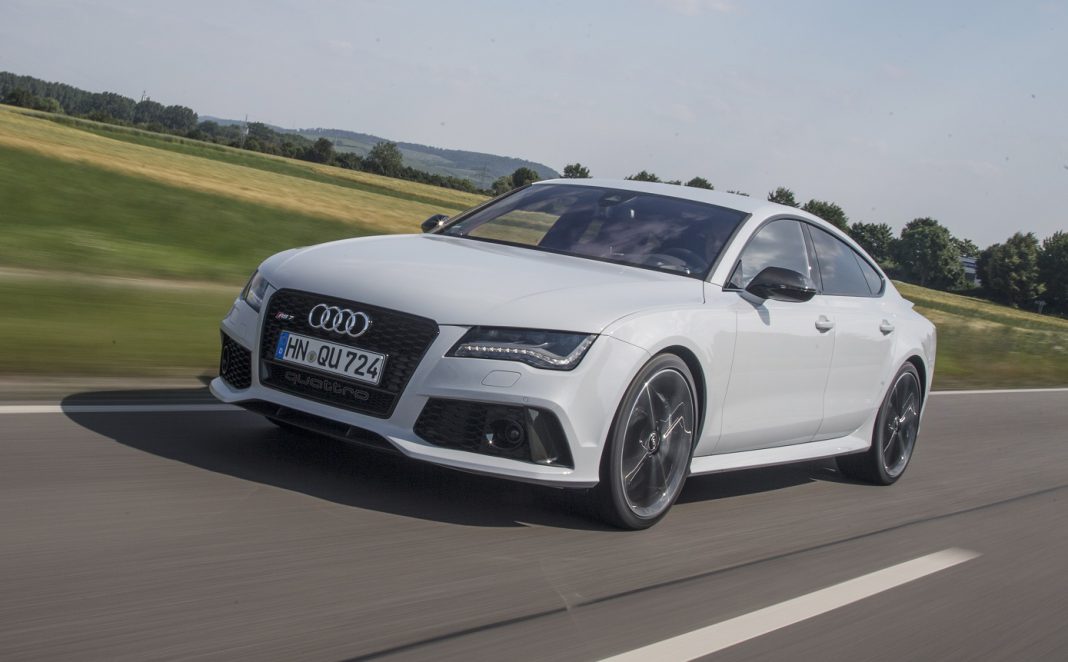
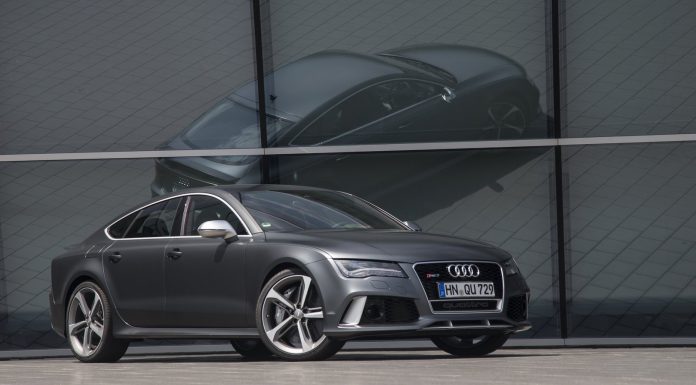
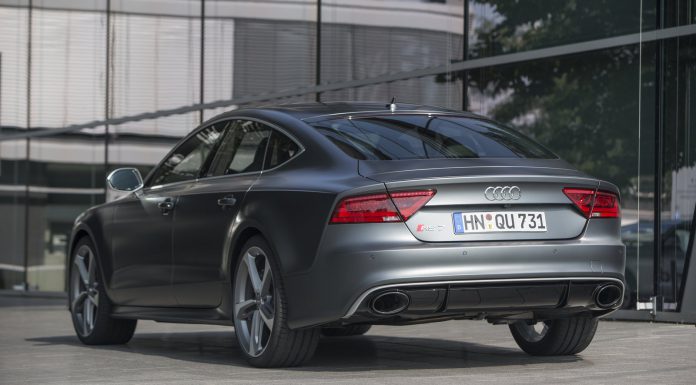










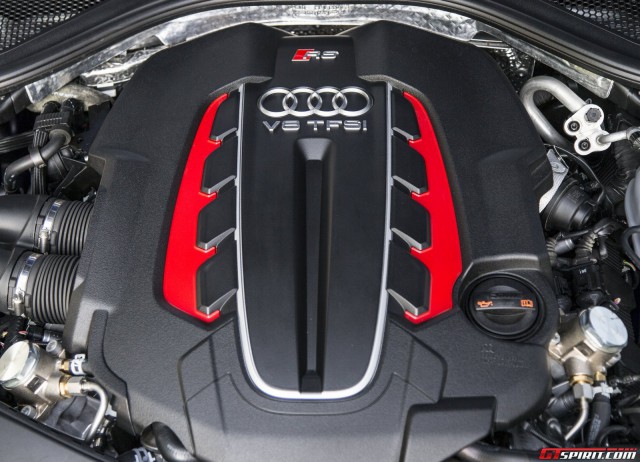
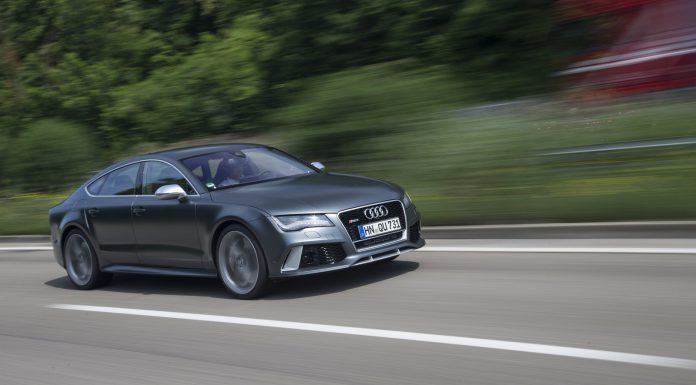
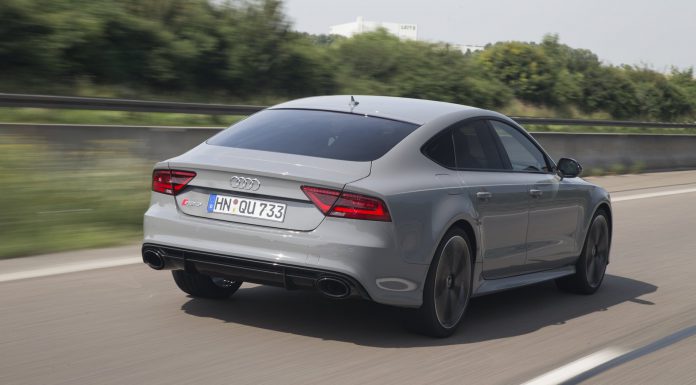
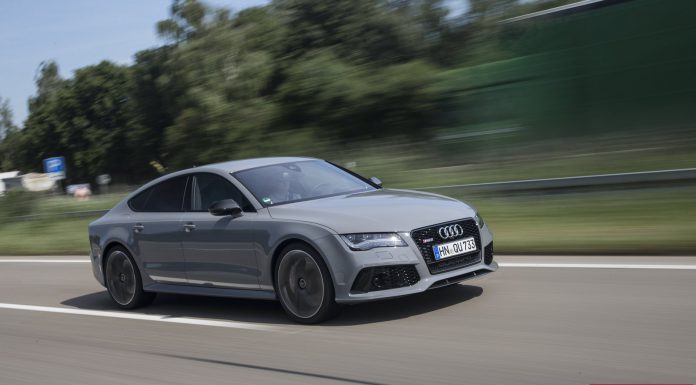

















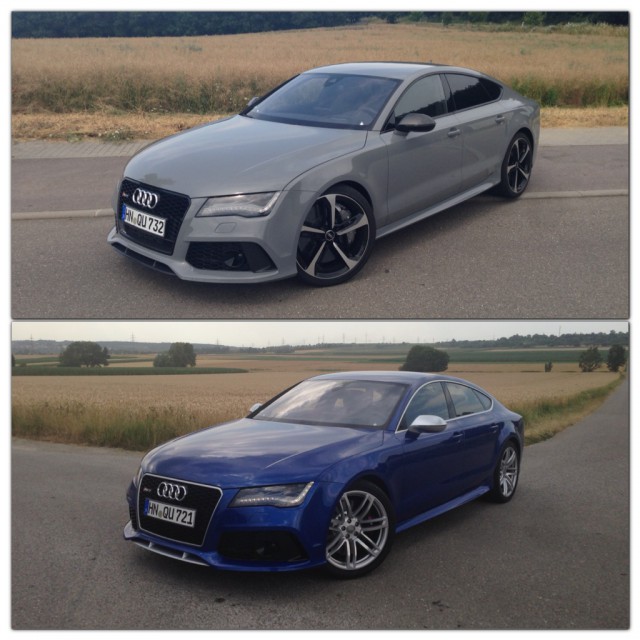

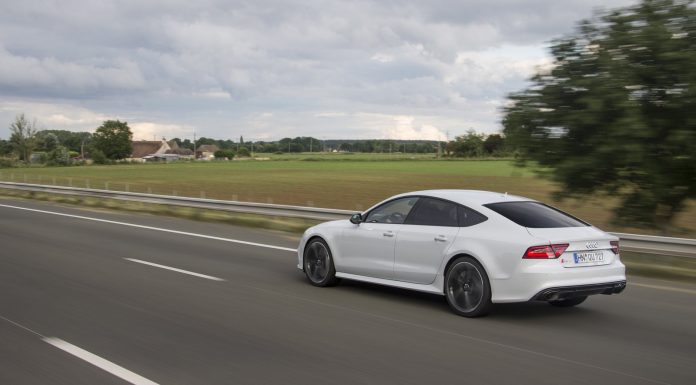










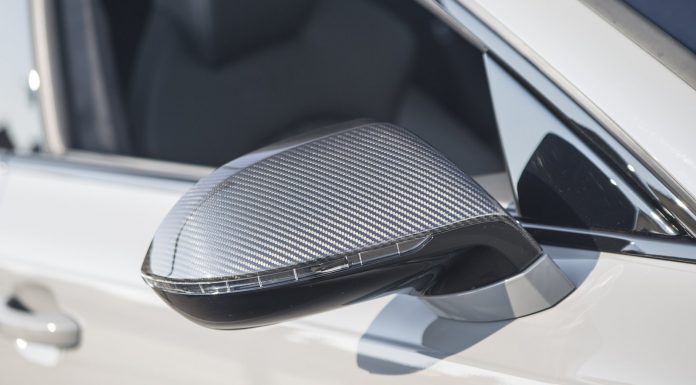

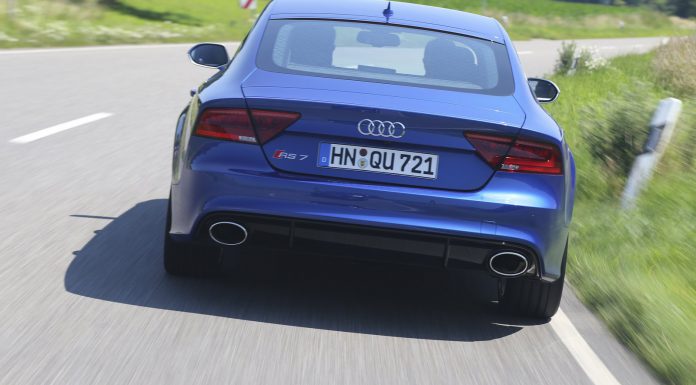










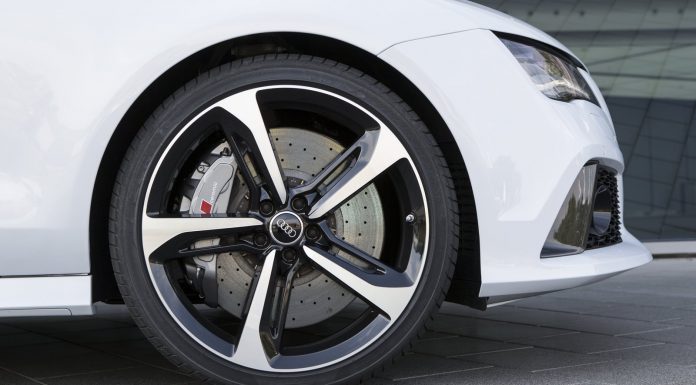
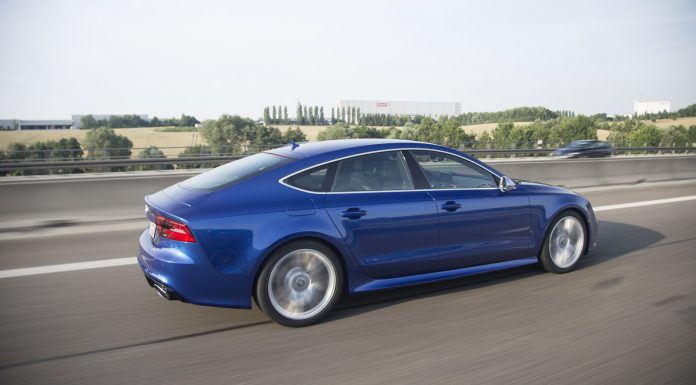
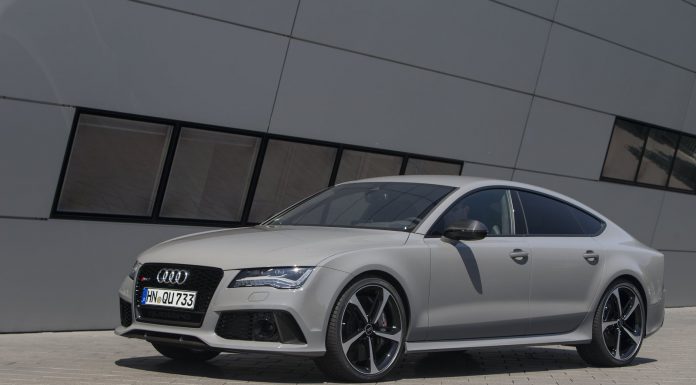











Sweet!
like the new package that can turn the mirror black ;).